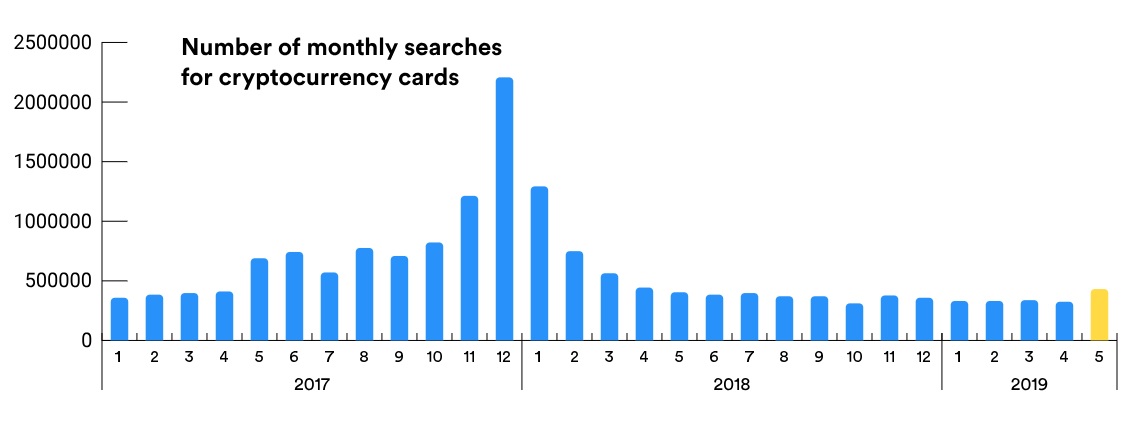The use of digital assets to make payments is growing, according to a recently published study. It reveals that cryptocurrency’s role as a viable means of payment has been expanding and this year’s market rebound has increased the turnover of crypto payments. The report suggests that debit cards linked to digital currency wallets will remain an important tool until wider adoption of direct cryptocurrency payments.
Also read: BCH Can Be the Global Coin for Daily Spending, Says Italian Crypto Executive
Crypto Payments Industry Expands With Growing Markets
The study highlights a general correlation between upward market trends and the expansion of the crypto payments industry. Its Compound Annual Growth Rate (CAGR) increased 21% between 2014 and 2015 and jumped over 600% two years later. But even during the bearish 2018, when the price of major cryptocurrencies took a hit, the sector’s CAGR expanded by around 90% year over year. The recovery that started this year has had a positive effect and the rising volume of payments this spring indicates that the recession is over.
The industry assessment has been conducted by Crypterium, a payment solutions provider that recently launched a crypto debit card, one of the few products in this niche that’s available globally. The analysis examines the performance of leading cryptocurrency payment providers such as Bitpay, Coinsbank, Cryptopay, Spectrocoin, Wirex, and Xapo. It covers two main types of services offered on the market: those allowing merchants to accept digital currency directly and solutions enabling customers to pay with crypto assets through conversion to fiat.

Statistical data gathered by Crypterium shows that the average value of transactions processed by the payment platforms stabilized during last year’s decline in a relatively narrow range between $1,000-2,000. The volume of crypto payments and the average amount have increased in 2019, reaching a seven-month high in April. The researchers believe that, helped by the crypto market recovery, the increasing number of payment providers in the sector which offer new solutions for both merchants and customers will help the industry achieve “gradual and sustainable organic growth.”
The report further identifies the regions that concentrate the most crypto holders who are using digital assets to make payments. The authors emphasize that the number of wallet addresses has been constantly growing and active wallets worldwide have reached 34 million in the first quarter of 2019, increasing by 44% just in the last 12 months. According to another study that news.Bitcoin.com covered in May, the figure is even higher – 36 million.
High Income Countries Adopt Cryptocurrency Payments Faster
A key finding in the Crypterium analysis is that cryptocurrency payments are more popular in high-income nations in general. Based on data for trading and mining activity from the largest digital asset exchanges and mining pools, Crypterium has shortlisted the top 20 countries. Coins are increasingly used as a payment instrument in the United States, United Kingdom, Russia and China. The company concludes that their adoption is triggered by different factors depending on the jurisdiction. The most common reasons to trust cryptocurrencies include the desire to maximize efficiency in payments and the need to protect assets against hyperinflation.
To better understand why people choose decentralized coins over traditional payment methods like cash, fiat payment processors and bank cards, the researchers have analyzed various factors such as debit and credit card ownership, internet accessibility, mobile phone ownership as well as macroeconomic indicators including gross domestic product (GDP) per capita and share of shadow economy. Based on their qualitative and quantitative assessment, they have grouped the leading 20 countries in three categories: Innovators, Shadows and Survivors.

The United States, Canada, Germany, France, England, the Netherlands, Italy, Spain, Japan, and South Korea are the so-called ‘innovators.’ They are characterized by deep penetration of banking and digital financial services and unrestricted access to mobile services. According to the authors, they offer the best opportunity for merchants to capitalize on increasing crypto adoption as most customers there have access to the internet and own a mobile device.
Medium to low income countries – Russia, China, Brazil, Poland, and Turkey – have been labeled as ‘shadows.’ Many of their citizens have lost trust in government institutions, banks and national currencies due to economic recessions. They often see cryptocurrencies as an alternative tool to make payments and receive income. The group of the ‘survivors’ includes Vietnam, India, Iran, Venezuela, and South Africa. Their populations have poor access to traditional banking services and they look at digital coins as a way to overcome economic challenges like hyperinflation and save on money transfers.
Debit Cards Remain Viable Option for Crypto Users
Until wider adoption comes around, debit cards tied to crypto wallets are likely to continue to offer the most applicable solution for cryptocurrency users who want to spend their electronic cash on a wide range of products and services. The prepaid cards that can be loaded with digital coins can be used in both brick and mortar stores and online platforms to purchase anything that can be bought with regular bank cards as they convert your crypto assets and merchants are paid with fiat money. They also allow you to withdraw cash directly from regular ATMs.
In its study, Crypterium, the issuer of a new crypto debit card, has mentioned five established platforms that provide this type of product: Wirex, which offers a crypto card in the European Economic Area, Coinbase, popular in the U.K., Bitpay, which is a working option for U.S. residents, Cryptopay, with its card available in the Russian Federation, and MCO, which issues Visa cards in Singapore. However, there are many more options on the market, as news.Bitcoin.com recently reported, such as Paycent, Uquid, Bitsa, and the ADV cards.

The team behind the in-depth analysis of the crypto payments sector notes the strong demand for cryptocurrency cards. Companies that launched such products saw their average monthly turnover figures increase three times, the authors claim. Again, there’s a correlation between the state of crypto markets and the interest in debit cards facilitating cryptocurrency payments. The number of monthly searches for ‘bitcoin cards’ has reached a 12-month high in May 2019. Users recognize the importance of these cards for mass crypto adoption. Almost 70% of the responders in Crypterium’s 2018 Customer Survey indicated that cryptocurrency cards are the best option to achieve that at the moment.
Former Visa Executive Leads Company Issuing Global Crypto Card
The future of crypto cards seems bright, as global payment card ownership in general is growing rapidly. The number of debit card owners is expected to double in less than a decade and according to the World Bank, it will reach 69% in 2020. Crypterium has one of the latest offerings in the market and it’s also one of the few that can be ordered anywhere in the world. The Global Bitcoin card launched recently with support for bitcoin core, ethereum, USD coin and Crypterium’s own token, CRPT. Nevertheless, the fintech company plans to expand their number with over a dozen other cryptos within a year and bitcoin cash (BCH) is one of the currencies it’s considering, Crypterium CEO Steven Parker assured news.Bitcoin.com.

“Cards is definitely a key part of the Crypterium proposition. A payment card is still the most convenient ‘channel’ to enter the mainstream payments eco-system and the easiest way to make a payment in the online and offline worlds and also withdraw your money in cash,” Parker emphasized. “So we do envisage a growing number of crypto cards. Our belief is that fiat cards enabling crypto transfers will indeed become a strong segment in cards. However, we do also see a big opportunity for NFC channels such as Apple Pay and Google Pay and we intend to launch those types of service by the end of the year. Also, our company roots are in QR codes and we are still seeing how we can integrate that type of functionality. QR codes are huge in China,” the executive added.
Steven Parker noted there are different flavors across different regions but he believes crypto payments will grow all around the world. “Of course, we see the highest ownership of cryptocurrencies in places like the U.S. and Korea. But as in payments generally, I think we shall see different adoption rates. Asia is already led by mobile payments, so I can imagine crypto payments growing faster there. We see large developing markets such as Brazil or Russia, as a big opportunity. And, of course, some of the more interesting consumer innovations – prompted by the Open Banking revolution – is happening in Europe,” he elaborated. The executive thinks crypto adoption can mirror local financial habits and Crypterium has integrated, for example, the ability to transfer in and out via Iban accounts.
Parker spent over seven years at Visa as General Manager for Central and Eastern Europe and Head of Marketing for the greater region that encompasses the Middle East and Africa as well. He was approached by Crypterium in late 2018 with a simple proposition: to make payments, especially person-to-person and cross-border, faster, more seamless and cheaper. He also recognizes that traditional financial services are expensive and exclude many people who don’t have access to bank accounts. Through services like those offered by his Estonia-based fintech company, anyone with a mobile phone can open up a wallet and immediately receive and make payments. “I think that’s amazing and the borderless nature of cryptocurrencies is what makes it possible,” the former Visa executive stated.
What is your take on the current state of cryptocurrency payments? Do you expect to see more crypto debit cards in the near future? Share your thoughts on the subject in the comments section below.
Images courtesy of Shutterstock, Crypterium.
Do you need a reliable Bitcoin mobile wallet to send, receive, and store your coins? Download one for free from us and then head to our Purchase Bitcoin page where you can quickly buy BCH and BTC with a credit card.
The post Market Rebound Boosts Adoption of Cryptocurrencies for Payments appeared first on Bitcoin News.
Powered by WPeMatico
